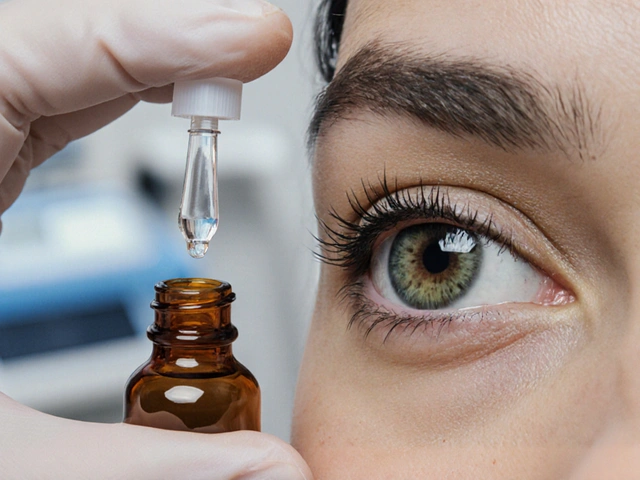When your body makes too much cortisol - the stress hormone that keeps you alert, regulates blood sugar, and controls inflammation - it doesn’t just make you feel on edge. It rewires your body. Your face swells into a round, moon-like shape. Fat piles onto your belly while your arms and legs stay thin. Purple stretch marks appear on your skin like bruises that never fade. Your bones weaken. Your blood pressure spikes. You get tired all the time, even after sleeping. This isn’t just being stressed out. This is Cushing’s syndrome.
What Exactly Is Cushing’s Syndrome?
Cushing’s syndrome happens when your body is flooded with cortisol for too long. Normal cortisol levels range from 5 to 25 micrograms per deciliter over 24 hours. In Cushing’s, they climb above 50 - sometimes over 200. That’s not a small bump. That’s a flood. There are two main ways this happens. Eight out of ten cases come from taking steroid medications like prednisone for conditions like asthma, lupus, or rheumatoid arthritis. That’s called exogenous Cushing’s. But the other two cases? Those are endogenous - your own body is making too much. And that’s where things get serious. Endogenous Cushing’s is rare. Only about 10 to 15 people out of every million get it each year. But it’s more common in women between 20 and 50. And if it’s not caught and treated, it can kill you. High cortisol raises your risk of heart attack, stroke, infection, and bone fractures. The longer it goes untreated, the harder it is to fix.How Do You Know You Have It?
The symptoms don’t sneak up. They show up loud and clear.- Your face becomes round and red - called moon facies - seen in about 70% of patients.
- A fatty hump builds up between your shoulders - a buffalo hump - present in 90%.
- Your abdomen swells, but your arms and legs stay skinny. You might gain 20 to 30 pounds in just months.
- Stretch marks appear, wide and purple, over your hips, thighs, and breasts. They’re not from pregnancy or weightlifting. They’re from cortisol breaking down your skin.
- Your blood pressure climbs. About 85% of people with Cushing’s have high blood pressure.
- Your blood sugar goes up. Around 70% develop prediabetes or type 2 diabetes.
- Your bones thin out. Half of patients have osteoporosis with a T-score below -2.5 - meaning your bones are fragile enough to break from a fall or even a sneeze.
What Causes the Body to Make Too Much Cortisol?
Your body makes cortisol in your adrenal glands, but it’s controlled by your brain. The pituitary gland releases ACTH, which tells your adrenals to make cortisol. So the problem can start in three places:- Pituitary tumor (Cushing’s disease): This is the most common cause of endogenous Cushing’s - 60 to 70% of cases. A tiny, usually benign tumor in your pituitary gland pumps out too much ACTH.
- Adrenal tumor: About 15 to 20% of cases. A tumor on one of your adrenal glands starts making cortisol on its own, ignoring the brain’s signals.
- Ectopic ACTH syndrome: 5 to 10% of cases. A tumor somewhere else - like your lungs, pancreas, or thymus - starts making ACTH. These are often cancerous and harder to treat.

Why Surgery Is the First-Line Treatment
Medications can help lower cortisol - drugs like pasireotide or mifepristone. But they don’t cure the problem. They just manage it. And they cost $5,000 to $10,000 a year. Plus, they come with side effects: nausea, fatigue, liver issues. Surgery is the only way to remove the root cause. And for endogenous Cushing’s, it’s the most effective option. The Endocrine Society’s 2020 guidelines say surgery should be the first step if the tumor can be reached. For pituitary tumors, the go-to procedure is transsphenoidal surgery. Surgeons go through your nose or upper gum, avoiding the skull. It takes 2 to 4 hours. You’re usually in the hospital for 2 to 5 days. Success rates? For small tumors (under 10 mm), remission happens in 80 to 90% of cases. For larger ones, it drops to 50 to 60%. For adrenal tumors, it’s laparoscopic adrenalectomy. Surgeons remove the affected adrenal gland through small cuts in your abdomen. It takes 1 to 2 hours. Hospital stay? Usually just 1 to 2 days. Success rate? Around 95%. Complications are rare - bleeding or infection happens in only 2 to 5% of cases.What Happens After Surgery?
You might think the problem ends when the tumor is removed. It doesn’t. Your body has been flooded with cortisol for months or years. Now, suddenly, it’s gone. Your adrenal glands - which have been sleeping - don’t know how to wake up. You go into adrenal insufficiency. That means you can’t make enough cortisol on your own. That’s why you need steroid replacement. Almost everyone needs hydrocortisone for 3 to 6 months. About 10% will need it for life. You’ll have to learn how to adjust your dose during stress - illness, injury, even dental work. If you don’t, you risk an adrenal crisis - low blood pressure, vomiting, passing out. It can be deadly. Recovery takes time. Most people feel better in 3 to 6 months. The moon face fades. The belly fat shrinks. Blood pressure drops. But fatigue lingers. Some people need thyroid or testosterone replacement. Emotional ups and downs are common. Body image issues stick around longer than you expect. A 2023 survey of 687 patients on the Cushing’s Support & Research Foundation forum showed 72% had dramatic improvement. One woman lost 40 pounds and got off blood pressure meds. But 28% still struggled. One man needed lifelong hormone therapy after bilateral surgery.When Surgery Isn’t Enough - Or Isn’t Possible
Sometimes, the tumor comes back. Or it’s too big to remove safely. Or you have bilateral adrenal hyperplasia - both glands overproducing. In those cases, doctors may remove both adrenal glands - a bilateral adrenalectomy. This cures the cortisol problem 100% of the time. But now you’re completely dependent on replacement hormones. And there’s a 40% chance you’ll develop Nelson’s syndrome - a fast-growing pituitary tumor that can spread. It’s rare, but dangerous. If surgery isn’t an option, medications are the backup. But they’re not perfect. They control cortisol, but they don’t fix the tumor. And they don’t reverse damage already done - like bone loss or heart strain.
Why Where You Get Surgery Matters
Not all surgeons are the same. This isn’t a routine procedure. It’s complex. And outcomes vary wildly. Centers that do fewer than 10 pituitary surgeries a year have remission rates of only 50 to 60%. Centers that do 20 or more? They hit 80 to 90%. That’s a huge difference. The key is experience. Surgeons who do this often know how to spot tiny tumors. They know how to avoid cerebrospinal fluid leaks - a complication that happens in 2 to 5% of cases. They know how to manage the adrenal crash afterward. New tech helps too. In 2023, the FDA approved a 3D endoscopic system that gives surgeons 0.5mm resolution. It cuts surgical time by 25% and reduces CSF leaks by 40%. Some hospitals now use robotic arms to steady the tools during delicate pituitary work. But access is still a problem. Only 15% of patients in the U.S. get treated at these high-volume centers. Insurance doesn’t always cover the travel. Many people end up with surgeons who don’t do this often enough.What You Can Do Now
If you suspect you have Cushing’s - because your symptoms match, or your doctor suspects it - don’t wait. Early treatment saves lives. Studies show patients who have surgery within two years of diagnosis have 30% higher remission rates. Delaying increases your risk of heart disease, diabetes, and death. Find a specialist. Look for an endocrinologist who works with a pituitary or adrenal surgery team. Ask how many Cushing’s surgeries they do a year. Ask about their remission rates. Don’t settle for a general surgeon or endocrinologist who doesn’t specialize in this. If you’ve had surgery, stick with your follow-up. Take your steroids as prescribed. Learn the signs of adrenal crisis. Keep your bone density scans up to date. Monitor your blood pressure and blood sugar. This isn’t a one-time fix. It’s a lifelong management plan.Hope Is Real - But It Takes Action
Cushing’s syndrome used to be a death sentence. Now, with the right care, most people recover. They go back to work. They play with their kids. They hike. They live. But recovery doesn’t happen by accident. It happens when you get diagnosed early. When you find the right team. When you push for surgery if you have a tumor. When you commit to the hard work of recovery. The numbers don’t lie. Surgery cures most cases. The risks are real - but manageable. The benefits? A life without moon face, without broken bones, without constant fatigue. You don’t have to live with this. There’s a path out. You just have to take the first step.Can Cushing’s syndrome be cured without surgery?
For cases caused by steroid medications, yes - stopping the drugs usually reverses symptoms over months. But for endogenous Cushing’s - where your body makes too much cortisol on its own - surgery is the only cure. Medications can lower cortisol levels, but they don’t remove the tumor causing the overproduction. They’re used when surgery isn’t possible or while waiting for it.
How long does it take to recover after Cushing’s surgery?
Most people notice improvements in 3 to 6 months - weight loss, better sleep, clearer skin. But full recovery can take up to a year. Fatigue, mood swings, and hormonal changes linger. Your adrenal glands need time to restart, so you’ll need steroid replacement for months. Returning to work usually takes 4 to 12 weeks for pituitary surgery, and 2 to 4 weeks for adrenal surgery.
What are the risks of pituitary surgery for Cushing’s?
The most common risks are temporary adrenal insufficiency (happens in 30-40% of patients), cerebrospinal fluid leak (2-5%), and infection (1-3%). Rarely, damage to the pituitary can cause lifelong hormone deficiencies. In experienced hands, serious complications are rare. The bigger risk is not having surgery - prolonged high cortisol leads to heart disease, stroke, and death.
Is bilateral adrenalectomy a good option?
It’s a last-resort option. It cures cortisol overproduction completely, but you’ll need lifelong hormone replacement for both cortisol and aldosterone. There’s also a 40% risk of Nelson’s syndrome - a fast-growing pituitary tumor - within 5 years. This surgery is usually only done when other treatments failed or if you have bilateral adrenal tumors.
Why do some people still have symptoms after surgery?
Even after successful surgery, some symptoms linger because cortisol damage takes time to reverse. Bone density doesn’t rebuild overnight. Muscle loss from prolonged high cortisol needs physical therapy. Fatigue may be due to lingering hormone imbalances or adrenal insufficiency. Some patients need additional treatments - thyroid, testosterone, or antidepressants - to fully recover. About 15-25% of patients see a recurrence within 10 years.
How do I find a high-volume Cushing’s surgery center?
Look for centers that perform at least 20 pituitary or adrenal surgeries per year. Ask your endocrinologist for referrals. Major academic hospitals - like Mayo Clinic, Cleveland Clinic, or NIH - have dedicated pituitary centers. The Endocrine Society recommends avoiding centers that do fewer than 10 cases annually. Check if the team includes a neurosurgeon, endocrinologist, and nurse coordinator who specialize in Cushing’s - that’s a sign of a high-quality program.






This post is basically a pharmaceutical ad disguised as medical advice. 🤡
Oh wow, so if you're not rich enough to fly to Mayo Clinic for some fancy nose surgery, you just die? Classic American healthcare. My cousin had this and got stuck with a local doc who'd never seen a pituitary tumor. He's still on hydrocortisone and can't lift a grocery bag. Thanks, capitalism.
Let me tell you something - this isn’t just about surgery or hormones, it’s about reclaiming your life. I watched my sister go from being the life of the party to barely getting out of bed, her skin like parchment, her bones cracking like dry twigs. She cried every night thinking she’d never dance again. Then she found a surgeon who did 40 of these a year. Two years later? She’s hiking in the Rockies, laughing, alive. This isn’t medicine - it’s a second chance. Don’t let fear or insurance bureaucracy steal that from you.
The clinical data presented here is accurate and aligns with current Endocrine Society guidelines. Early surgical intervention remains the gold standard for endogenous Cushing’s syndrome, particularly when a resectable tumor is identified. Postoperative adrenal insufficiency is expected and requires careful glucocorticoid tapering under endocrine supervision. Patient education regarding adrenal crisis prevention is critical to long-term outcomes.
So we’re supposed to believe that the solution to a disease caused by your own body going haywire is… more surgery? And if that fails, you cut out both glands and become a walking hormone pump? And if that fails, you get Nelson’s syndrome - which is basically your pituitary going full horror movie? Wow. We’ve turned the human body into a broken appliance you fix by swapping parts. Maybe we should ask why it broke in the first place. Or is that too philosophical for a system that bills by the incision?
Look, I get it - you’re scared. You’ve got moon face, you can’t tie your shoes without gasping, and your doctor says ‘surgery.’ But here’s the thing: this isn’t a choice between ‘surgery or die.’ It’s a choice between ‘surgery now or suffer longer.’ I’ve been there. The first week after surgery? You feel like you’re dying. But by week 6? You’re breathing again. By month 3? You’re crying because you forgot what your own voice sounded like without exhaustion. It’s brutal. But it’s worth it. Don’t wait. Find your specialist. Push. Even if they say no. Push again.
Why do they always make it sound like surgery is the only option? What about diet? Stress reduction? Chiropractic? I mean, cortisol’s a stress hormone - maybe if you just meditated more and stopped eating gluten, you wouldn’t need a surgeon poking around your nose? Also, why is everyone so obsessed with ‘high-volume centers’? Sounds like a marketing scam to me. My uncle had this and he just took some herbs. He’s fine.
Imagine your body is a symphony. Cortisol is the conductor - normally, it cues the violins, the brass, the timpani in perfect harmony. But when a tumor hijacks the podium? Suddenly, the tuba’s playing solo at 110 decibels while the cellos are muted. The music becomes noise. Surgery doesn’t just remove the rogue conductor - it gives your body back its rhythm. But here’s the kicker: after the surgery, you’re not just silent - you’re deaf. The orchestra forgot how to play without the tyrant. So you need a new conductor - synthetic cortisol - until your musicians remember their parts. That’s why recovery isn’t linear. It’s not ‘fixed.’ It’s relearning how to be human again.
To anyone reading this who’s scared - you’re not alone. I had this. I felt like a monster in the mirror. I hid from photos. I stopped seeing friends. But I found a team - real people, not just doctors - who listened. They didn’t rush me. They didn’t make me feel broken. They just said, ‘We’ve got you.’ Surgery wasn’t magic. Recovery wasn’t easy. But I got my life back. And if you’re reading this right now? You’re already stronger than you think. Take the first step. Even if it’s just calling one specialist. You deserve to breathe again.
Let’s be honest: this whole post reads like a pharmaceutical sales pitch with extra steps. ‘Surgery is the only cure!’ - said the guy who owns the surgical center. ‘Medications are expensive!’ - said the guy who profits from your desperation. Meanwhile, the real issue? Why is cortisol running rampant in the first place? Environmental toxins? Chronic stress? Sleep deprivation? Nah, let’s just cut something out. Because that’s easier than fixing the system. Or your lifestyle. Or your trauma. But hey, at least you’ll have a nice scar and a lifetime of pills.
just had this surgery last year… still cant believe how much i look like me again… like, i forgot what my jawline looked like… and my skin… god my skin… used to look like i was bruised all the time… now i can wear a tank top without feeling like a freak… but man… the adrenal crash… i thought i was dying… like, i cried for three days straight… but i got through it… you can too… just find the right doc… dont settle…
Oh wow, so if you're poor, you just die? And if you're not white and middle-class, your tumor doesn't count? I'm sure this all works perfectly in Beverly Hills. Meanwhile, my cousin in Alabama had to wait 14 months because her insurance 'didn't cover travel.' She lost 30% of her bone density. And now she's on disability. So yeah, 'surgery is the cure' - if you can afford to fly to a city you've never heard of, with a doctor who doesn't look like you. Thanks for the optimism, doc.
It is essential to emphasize that transsphenoidal surgery for Cushing’s disease, when performed by experienced neurosurgeons at high-volume centers, achieves remission rates exceeding 85% in microadenomas. The 2023 FDA-approved 3D endoscopic systems have demonstrably reduced cerebrospinal fluid leak rates by 40%, as documented in the Journal of Neurosurgery. Patients must be counseled on lifelong adrenal insufficiency risks and the necessity of stress-dose steroid protocols. Delayed diagnosis correlates strongly with increased mortality; therefore, early referral to endocrine surgery centers is not merely optimal - it is imperative.
Everyone’s acting like this is some miracle cure. Let’s not pretend surgery doesn’t come with its own horrors. You lose your identity for months. You’re a zombie on pills. You can’t cry without feeling like you’re going to collapse. And if the tumor comes back? Then you get blasted with radiation or lose both adrenal glands - and then you’re just a walking IV drip. We’re glorifying a system that treats bodies like machines. What if the real problem isn’t the tumor - but a culture that lets stress, pollution, and greed turn our biology against us? We fix the symptom. We never fix the cause. And that’s the real tragedy.
My mate had this last year in Dublin - got the surgery at St. James’s. Best thing he ever did. They’re bloody brilliant there. He’s back to playing soccer with his lads now. Don’t listen to the naysayers - if you’ve got the symptoms, chase the specialist. It’s not easy, but it’s worth it. And yeah, you’ll be on pills for a bit - but better than being dead, eh?